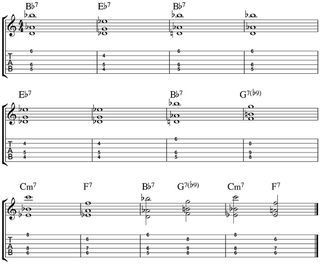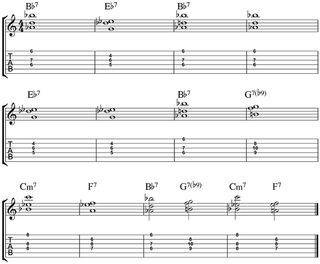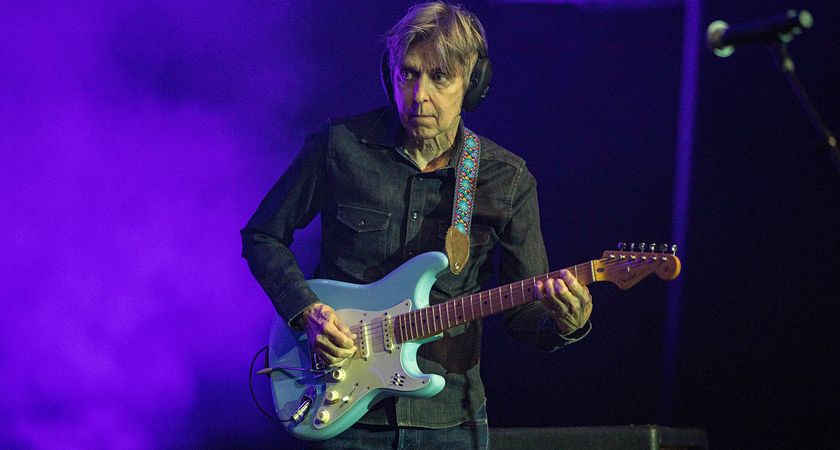Jazz Guitar Corner: Using Two-Note Chords to Play the Blues, Part 3

In today’s lesson, the third part in our series about two-note chords, we’re going to look at adding one note on top of the 3rd and 7th shapes you learned in the previous two lessons.
When doing so, you begin to create a “two hands of the piano”-type feel, especially when rhythmic variation is involved — as is the case in Example 3 in this lesson.
If you are using your fingers to play these chords, or a hybrid picking approach, you might also want to try making the root note a bit louder than the underlying 3rds and 7ths, as this will keep a sense of separation between those two sounds, instead of bunching them too much together with their volume levels.
To check out the first two lessons in this series, please visit the links below:
• Jazz Guitar Corner: Using Two-Note Chords to Play the Blues, Part 1
• Jazz Guitar Corner: Using Two-Note Chords to Play the Blues, Part 2
Root on Top: Example 1
To get started, let’s take a look at adding the root note of each 3rd and 7th of a Bb blues chord progression. In this example, you’ll be putting the 3rd and 7th of each chord on the 5th and 4th strings, and the root note will fall on the first or second string of the guitar.
This can be a bit of a stretch, and there are a lot of muted strings between the low notes and the root, so fingerpicking or hybrid picking is always a good idea with these types of chords, so that you don’t risk hitting any unwanted strings if you strum these shapes instead.

Try playing through each chord without any time or tempo at first — just to get a feel for these shapes on the neck. Then, when that is comfortable, you can begin to add in tempo with a metronome or backing track, as well as begin to alter the rhythm of each chord in order to make these shapes less technical and more musical in your practice routine.
Root on Top: Example 2
As well as adding the root above the 3rd and 7th as we did in the first example, you can add the root above any position that you know for two-note chords on the blues. Here’s an example of how you would add the root note above each chord when you have the 3rd and 7th on the third and fourth strings on the neck.

Once you have these two shapes under your fingers, the first two examples of 3rds and 7ths with the root notes on top, try mixing them together in the practice room. So, play one time through a blues in Bb using the fifth- and fourth-string 3rds and 7ths, with the root on top. The second time through, switch to the third- and fouth-string 3rds and 7ths with the root on top.
This will help you get a feel for how these shapes sit in different areas of the neck as you begin taking them to tunes and jamming situations on the guitar.
Root on Top Rhythmic Exercise
Once you have the root under your fingers, when added on top of a two-note chord, you can start to play around with the placement of that root throughout the bar. Here is an example of a rhythmic pattern I like to use with the root on top of two-note chords, where the root is played on the 1 and the "and" of 2 each bar.
It may seem like a simple exercise, but it can be tricky to get perfectly in time, so go slow and work with a metronome as you explore this idea further in the woodshed.

After exploring this rhythmic example in the practice room, come up with your own variations on this exercise, where you place the root over the 3rd and 7ths in different parts of the bar.
Though it is a simple idea, just playing the root of each chord above the 3rd and 7th, it can really bring a fun and exciting new texture to your blues chord ideas.
Do you have any questions about adding the root on top of two-note, 3rd and 7th chords? Share your thoughts in the comments section below!
Matt Warnock is the owner of mattwarnockguitar.com, a free website that provides hundreds of lessons and resources designed to help guitarists of all experience levels meet their practice and performance goals. Matt lives in the UK, where he is a lecturer in Popular Music Performance at the University of Chester and an examiner for the London College of Music (Registry of Guitar Tutors).
Get The Pick Newsletter
All the latest guitar news, interviews, lessons, reviews, deals and more, direct to your inbox!
Matt Warnock is the owner of mattwarnockguitar.com, a free website that provides hundreds of lessons and resources designed to help guitarists of all experience levels meet their practice and performance goals. Matt lives in the UK, where he teaches Skype guitar students all over the world, and is an examiner for the London College of Music (Registry of Guitar Tutors).




![Joe Bonamassa [left] wears a deep blue suit and polka-dotted shirt and plays his green refin Strat; the late Irish blues legend Rory Gallagher [right] screams and inflicts some punishment on his heavily worn number one Stratocaster.](https://cdn.mos.cms.futurecdn.net/cw28h7UBcTVfTLs7p7eiLe-840-80.jpg)








